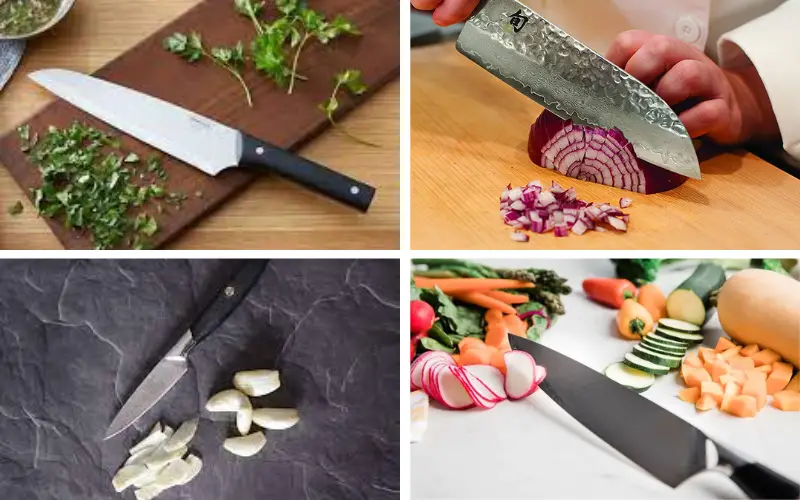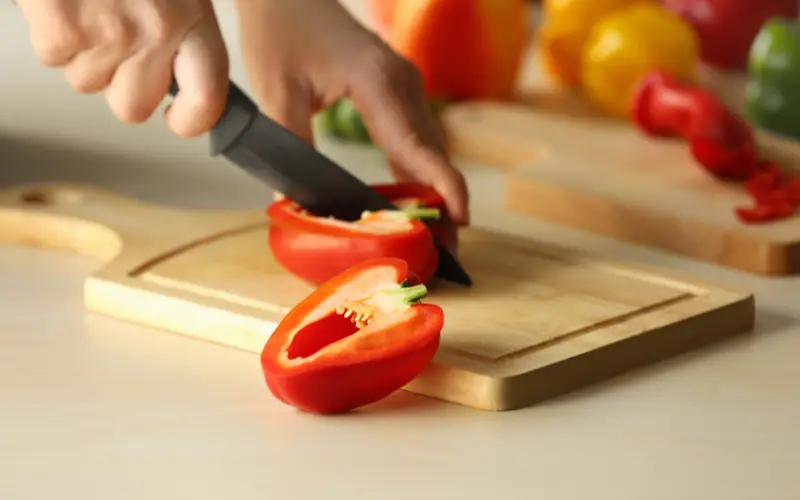Short answer: To slice vegetables like a chef, you need to master knife skills, ensuring even, precise cuts for uniform cooking and presentation. Also, understanding each vegetable’s texture and structure can help you decide the best method to slice it.
Properly slicing vegetables isn’t just about making your plate look aesthetically pleasing. It’s a crucial skill that can help improve the taste and texture of your dishes, make your cooking process more efficient, and even enhance safety in your kitchen. However, with a few tips and tricks, you can easily slice vegetables like a pro in no time. Whether you’re preparing a simple salad or a complex dish, knowing how to slice vegetables correctly can make all the difference in the final outcome.
Which Knives Do Chefs Use For Slicing Vegetables?

Chefs use a variety of knives for slicing vegetables, each designed to handle specific tasks efficiently. Here are some common types:
- Chef’s Knife: This is the most versatile knife in the kitchen and is typically 6 to 12 inches long. Its broad blade dices, slices, and chops fruits, vegetables, and meats with ease. This knife is essential for almost every task.
- Santoku Knife: The Santoku knife is a Japanese version of the chef’s knife. It’s shorter, lighter, and sharper, with a ‘sheep’s foot’ tip that curves at an angle approaching 60 degrees at the point rather than the chef’s knife’s pointed tip. This knife is perfect for chopping, dicing, and slicing.
- Paring Knife: A small knife with a sharp point. Its size makes it perfect for peeling and cutting small fruits and vegetables.
- Utility Knife: Smaller than a chef’s knife but larger than a paring knife, a utility knife is good for a multitude of small tasks where more precise cuts are needed.
- Vegetable (Nakiri) Knife: Nakiri knives have a flat blade perfect for push cuts, where you push the knife straight down into the food. The thin and sharp edge gets very close to the chopping board, making it perfect for chopping vegetables.
Understanding Your Equipment

Before you get started, it’s crucial to understand the importance of the right tools. Here’s what you’ll need:
- A Knife: Preferably, an 8-inch chef knife. Remember to hold it with your thumb and index finger pinching both sides of the blade’s top. Your other three fingers should rest on the handle for a firm grip.
- A Cutting Board: Choose a bamboo cutting board, a safer choice over slippery glass ones.
- A Damp Paper Towel: Slip this under your cutting board to stop it from moving around.
How To Hold The Knife For Slicing Vegetables?
Properly gripping your knife is fundamental to slicing vegetables like a chef. The method often used by professionals is called the “pinch grip” or “chef’s grip”. Here’s how you do it:
- Position your hand: Hold out your hand in a relaxed position, fingers extended, thumb and forefinger pointing towards each other forming a “C”.
- Grip the blade: Position the knife so that the back end of the blade (nearest the handle) is inside the “C”. Use your thumb and forefinger to pinch the blade. The spot you are pinching should be around where the handle and the blade meet.
- Rest of the fingers: Curl your remaining three fingers (middle, ring, and pinky) around the handle of the knife. They should not be gripping it too tightly, but rather lightly holding it.
- The thumb and forefinger: They provide control and direction, while the other fingers provide force for the cuts.
Remember that the grip should be firm yet comfortable. Your fingers should be relaxed, not rigid. Your hand should feel secure and the knife should feel like an extension of your arm. With this grip, you will have maximum control over the knife, which allows for more precise and safe cuts. This grip also reduces the risk of the knife slipping out of your hand, resulting in less fatigue and potential accidents. Practice this grip, and you will be on your way to slicing vegetables like a chef.
How To Slice Vegetables Like A Chef?
Mastering the Onion:
Step 1: Cut the onion from the root end to the stem end.
Step 2: Lay the onion flat and remove the end where the stem was.
Step 3: Peel off the outer layer.
Step 4: For thin slices, hold the onion in a claw grip and make thin slices with the knife’s tip staying down.
Step 5: For dicing, make vertical slices without cutting through the root end. Then, turn and use the same cutting technique to get a nice dice.
Slicing Green Onions or Scallions:
Step 1: Remove the hairy end and the outer layer piece.
Step 2: Make thin slices for a delicate flavor in your dishes.
Step 3: For dicing, slice down the middle, turn it 90 degrees, and slice again.
Slicing Garlic:
Step 1: Remove the tip of the garlic clove that’s connected to the head.
Step 2: Place your knife flat on the clove and give it a hit to peel off the outer shell.
Step 3: Use the claw grip and dice the garlic the same way as the onion.
Bell Peppers:
Step 1: Remove the top, the bottom, and the inner ribs.
Step 2: Cut it into quarters.
Step 3: Ensure the shiny side or outer side of the bell pepper is facing down.
Step 4: Make thin chops to achieve a julienne slice and then dice it.
Getting the Zest out of Ginger
Step 1: Use a spoon to scrape off the ginger’s skin.
Step 2: Cut around the fibrous center, leaving it behind.
Step 3: Make thin slices and then dice them.
Cutting Mushrooms:
Cutting mushrooms like a professional chef requires careful knife work and attention to detail. Here’s how you can do it:
Step 1: Cleaning: It’s important to clean the mushrooms. Since mushrooms can absorb water, avoid washing them directly under a tap. Instead, wipe them clean with a damp paper towel or use a soft brush to remove any dirt.
Step 2: Removing the Stem: Depending on the type of mushroom and the dish you’re preparing, you might want to remove the stem. For instance, with button mushrooms, you can generally keep the stems on. However, with larger, more mature mushrooms, the stems may be woody and inedible, so you would remove them. Simply twist and pull off the stem, or cut it off at the base of the cap using a sharp knife.
Step 3: Slicing: Hold the mushroom on the cutting board with your fingers curled under for safety (this is known as the “claw grip”). Using a sharp knife, slice the mushroom vertically from the top of the cap down to the cutting board. The thickness of the slices depends on the recipe – thinner slices will cook more quickly, while thicker slices are better for dishes that require a longer cooking time.
Step 4: Dicing: If your recipe calls for diced mushrooms, first slice them as described above. Then, rotate the slices 90 degrees and cut them again into small cubes.
Step 5: Julienne or Matchstick Cut: For a julienne cut, first remove the stem and place the mushroom cap gill-side-down on the cutting board. Slice the cap into thin strips.
Step 6:Chopping: You can use a rocking motion with the knife for chopped mushrooms. Cut the mushrooms into slices, then keep your knife’s tip on the cutting board while you lift and lower the handle, moving the blade across the mushroom pieces until they’re chopped to the desired size.
What Are Some Techniques For Chopping Vegetables?
There are several techniques used by chefs for chopping vegetables. Here are a few:
- The Julienne: This involves cutting the vegetable into long, thin strips. Start by trimming off the ends, then cutting the vegetable into slices. Stack the slices and cut them lengthwise again into thin sticks. This cut is often used for carrots, bell peppers, and zucchini in stir-fry dishes.
- The Dice: This technique can result in small, medium, or large cubes, depending on the recipe. Begin by slicing your vegetable lengthwise, then turn the slices sideways and cut again to create cubes. This is a common cut for onions, peppers, and cucumbers.
- The Chiffonade: This technique is typically used for leafy greens and herbs. Stack the leaves on top of each other, roll them tightly, and then slice them perpendicular to the roll to create thin ribbons.
- The Batonnet: This is a larger version of the Julienne cut. Batonnet pieces are about 1/4 inch x 1/4 inch x 2-2.5 inches. This cut is commonly used for carrots, celery, or potatoes in dishes like stews or roasts.
- The Mince: This is a very fine chop, usually used for ingredients like garlic, ginger, or fresh herbs. The goal is to cut the vegetable into pieces as small as possible.
- The Rough Chop: This involves cutting the vegetable into irregular pieces. The size can depend on the recipe, but generally, rough-chopped vegetables are around one-inch pieces.
- The Rondelle: This is simply a round or diagonal slice, typically used for cylindrical vegetables like cucumbers, carrots, and zucchini.
Tips For Slicing Vegetables
- Finger placement is crucial when chopping vegetables to avoid injuries.
- When chopping garlic, the technique involves pressing down on the garlic with the knife to flatten it before chopping, which makes it easier.
- When cutting leafy vegetables, like coriander, gather the leaves together to cut them evenly.
- Always use a sharp knife to cut vegetables. A blunt knife can require more pressure, potentially leading to accidents and subpar results.
- When dicing a capsicum, remove all the seeds and white parts. It is easier to cut into small pieces from the inside.
- The onion should always be peeled when it’s halved, as peeling a round onion can be difficult.
- When cutting, the top side of the onion should be used, not the root side. The easiest cut is the slice, which follows the lines of the onion’s layers.
FAQs
How to sharpen a kitchen knife?
Use honing steel or sharpening stone. Run the blade along the steel or stone at an angle of approximately 15 degrees.
How to clean a kitchen knife?
Wash it with warm soapy water, rinse it thoroughly, and then dry it with a clean towel immediately to prevent rusting.
How often should I sharpen my knife?
It depends on how often you use it, but as a general rule, you should sharpen it every few weeks.
How can I slice onions without crying?
Chill the onions for about 15 minutes before cutting, as this can reduce the enzymes that cause your eyes to water. Also, using a sharp knife can minimize damage to the onion’s cell structure and lessen the release of irritants.
Is there a difference in the way different vegetables should be sliced?
Yes, different vegetables may require different slicing techniques. For example, leafy greens might need a ‘chiffonade’ cut, while carrots are often sliced into rounds or julienned.
Conclusion
Slicing vegetables like a chef involves a combination of using the right tools, understanding the correct techniques, and lots of practice. Utilizing a proper chef’s knife and ensuring it remains sharp is crucial for precision and safety. Learning the specific methods for different vegetables can significantly improve the appearance and cooking results of your dishes.

Mario Batali is a renowned author, food enthusiast, and passionate chef who has dedicated his life to exploring the world of culinary arts. With a love for sharing his knowledge and experiences, Mario has become a prominent figure in the food blogging community, inspiring countless readers with his creativity and expertise.
In addition to his culinary prowess, Mario Batali is also a talented writer with a flair for engaging storytelling. He launched his own food blog to share his recipes, cooking tips, and personal experiences in the kitchen. Over time, Mario’s blog gained a loyal following of food enthusiasts who appreciate his unique approach to cooking and his dedication to using only the finest ingredients.
Mario Batali’s passion for food and his commitment to sharing his knowledge with others have made him a true inspiration in the world of culinary arts. Through his blog, cookbooks, and public appearances, Mario continues to spread his love of food and the joy of cooking with his ever-growing fanbase.







